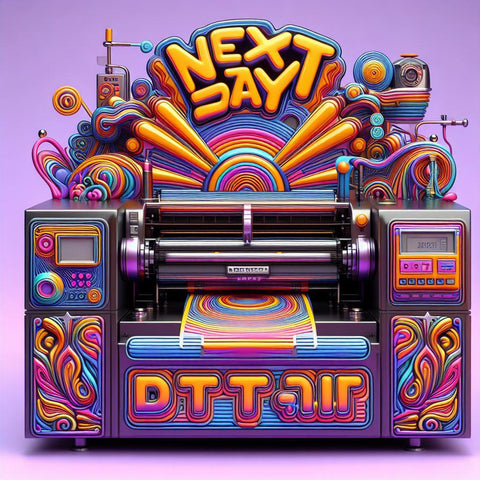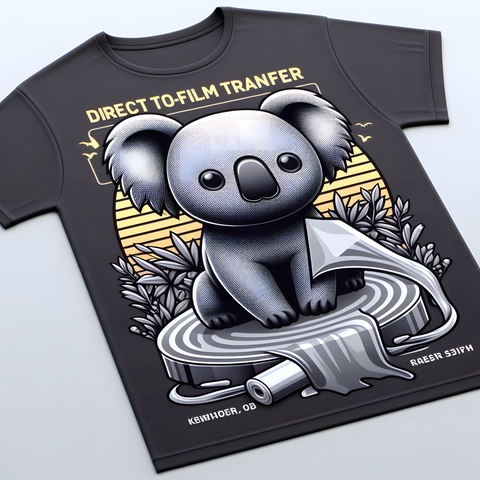Article Outline
-
Introduction
- Brief explanation of DTF transfers
- Importance and applications in various industries
-
Understanding DTF Technology
- Explanation of direct to film technology
- Comparison with other transfer methods
-
The Mechanics Behind DTF Transfers
- Detailed process of DTF transfers
- Equipment and materials required
-
Choosing the Right Films for DTF Transfers
- Factors to consider in film selection
- Different types of films available in the market
-
Preparing Artwork for DTF Printing
- Best practices for creating DTF-compatible designs
- Common mistakes to avoid in artwork preparation
-
Setting Up DTF Printing Equipment
- Step-by-step guide to setting up DTF printers
- Calibration and testing procedures
-
DTF Printing in Action
- Walkthrough of the printing process
- Troubleshooting common issues during printing
-
Advantages of DTF Transfers
- Cost-effectiveness compared to other methods
- High-resolution and vibrant prints
-
Limitations and Challenges
- Addressing common challenges in DTF transfers
- Tips for overcoming limitations
-
Applications of DTF Transfers
- Industries benefiting from DTF technology
- Creative possibilities in custom printing
-
Quality Control in DTF Printing
- Implementing quality control measures
- Ensuring consistency in output
-
Tips for Successful DTF Business
- Starting a DTF printing business
- Marketing strategies for DTF services
-
Environmental Impact of DTF Transfers
- Eco-friendly aspects of DTF technology
- Comparisons with traditional printing methods
-
Future Trends in DTF Technology
- Emerging innovations in DTF transfers
- Potential advancements in the near future
-
Conclusion
- Recap of key points
- Encouragement for readers to explore DTF transfers
How Do DTF Transfers Work? (Direct to Film)
Imagine a world where printing intricate designs on various surfaces is not only efficient but also cost-effective. Direct to Film (DTF) transfers bring this imagination to life, revolutionizing the way we approach custom printing. In this article, we'll unravel the mysteries of DTF technology, from its mechanics to applications, and explore how it's changing the game in the printing industry.
Understanding DTF Technology
DTF, or direct to film, is a cutting-edge technology that allows for the direct transfer of designs onto different surfaces. Unlike traditional methods, DTF eliminates the need for multiple steps, providing a more streamlined and effective printing process. But how does it really work, and what sets it apart from other transfer methods?
The Mechanics Behind DTF Transfers
At the heart of DTF technology lies a fascinating process. Designs are printed directly onto a special film, which serves as the intermediary for transferring onto the final surface. This method offers incredible precision and detail, making it ideal for intricate designs and complex images. To dive deeper, let's explore the step-by-step mechanics involved and the essential equipment required.
Choosing the Right Films for DTF Transfers
Not all films are created equal when it comes to DTF transfers. The choice of film plays a crucial role in the success of the printing process. Factors such as transparency, thickness, and adhesion properties must be considered. In this section, we'll guide you through the criteria for selecting the perfect film and introduce you to the variety available in the market.
Preparing Artwork for DTF Printing
Creating designs that seamlessly translate into stunning prints is an art in itself. We'll walk you through best practices for preparing artwork that's compatible with DTF printing. From color profiles to image resolution, learn the nuances that can make or break your DTF transfer.
Setting Up DTF Printing Equipment
Getting started with DTF printing requires proper setup and calibration of equipment. In this section, we provide a step-by-step guide to help you navigate through the initial stages. Whether you're a beginner or an experienced printer, understanding the setup process is key to achieving consistent and high-quality results.
DTF Printing in Action
With everything in place, it's time to witness DTF printing in action. We'll take you through the entire process, highlighting potential pitfalls and offering troubleshooting tips. Get ready to see how your designs come to life with vibrant colors and intricate details.
Advantages of DTF Transfers
Why choose DTF over other printing methods? This section explores the advantages that make DTF transfers a game-changer in the industry. From cost-effectiveness to the ability to achieve high-resolution prints, discover how DTF stands out in the competitive world of custom printing.
Limitations and Challenges
While DTF transfers offer numerous benefits, it's essential to be aware of potential limitations and challenges. From film compatibility issues to color matching concerns, we address common challenges and provide practical tips to overcome them.
Applications of DTF Transfers
DTF technology isn't limited to a specific industry. From apparel and promotional products to signage and personalized gifts, explore the diverse applications of DTF transfers. Uncover the creative possibilities that this versatile technology brings to the table.
Quality Control in DTF Printing
Maintaining consistent quality is paramount in the printing business. In this section, we discuss the importance of implementing quality control measures for DTF transfers. Learn how to ensure every print meets the highest standards, leaving your clients impressed.
Tips for Successful DTF Business
For entrepreneurs looking to venture into the world of DTF printing, this section provides valuable insights. From setting up your business to effective marketing strategies, discover the key elements for running a successful DTF printing enterprise.
Environmental Impact of DTF Transfers
In an era where sustainability is a top priority, explore the eco-friendly aspects of DTF technology. We compare DTF transfers with traditional printing methods, shedding light on how this innovation contributes to a greener and more environmentally conscious printing industry.
Future Trends in DTF Technology
As technology continues to evolve, what does the future hold for DTF transfers? In this section, we delve into emerging innovations and potential advancements in DTF technology. Stay ahead of the curve and explore what's on the horizon for this revolutionary printing method.
Conclusion
In conclusion, DTF transfers have transformed the way we approach custom printing, offering efficiency, precision, and versatility. Whether you're a seasoned printer or someone exploring the world of custom design, DTF technology opens up a realm of possibilities. Embrace the future of printing with DTF transfers and elevate your creative endeavors.
FAQs (Frequently Asked Questions)
-
Can DTF transfers be used on various materials?
- Yes, DTF technology is versatile and compatible with a wide range of materials, including fabric, plastic, and metal.
-
How do I troubleshoot color inconsistencies in DTF prints?
- Check your color profiles and ensure they are calibrated correctly. Additionally, verify the compatibility of the ink and film.
-
Are DTF transfers environmentally friendly?
- Compared to traditional methods, DTF transfers have a lower environmental impact, making them a more sustainable option.
-
What trends can we expect to see in the DTF printing industry in the coming years?
- The industry is moving towards faster printing speeds, improved color accuracy, and increased compatibility with various materials. Stay tuned for exciting developments!





Comments (0)
There are no comments for this article. Be the first one to leave a message!